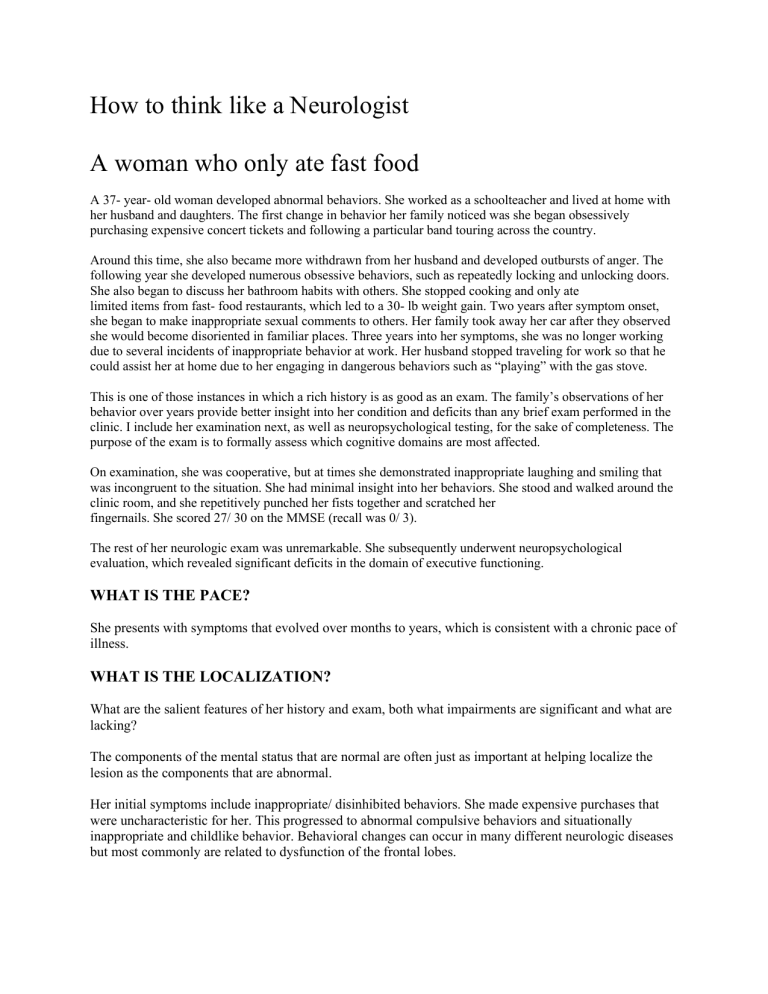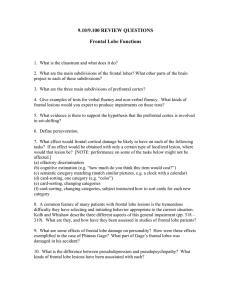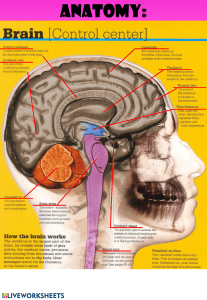
How to think like a Neurologist A woman who only ate fast food A 37- year- old woman developed abnormal behaviors. She worked as a schoolteacher and lived at home with her husband and daughters. The first change in behavior her family noticed was she began obsessively purchasing expensive concert tickets and following a particular band touring across the country. Around this time, she also became more withdrawn from her husband and developed outbursts of anger. The following year she developed numerous obsessive behaviors, such as repeatedly locking and unlocking doors. She also began to discuss her bathroom habits with others. She stopped cooking and only ate limited items from fast- food restaurants, which led to a 30- lb weight gain. Two years after symptom onset, she began to make inappropriate sexual comments to others. Her family took away her car after they observed she would become disoriented in familiar places. Three years into her symptoms, she was no longer working due to several incidents of inappropriate behavior at work. Her husband stopped traveling for work so that he could assist her at home due to her engaging in dangerous behaviors such as “playing” with the gas stove. This is one of those instances in which a rich history is as good as an exam. The family’s observations of her behavior over years provide better insight into her condition and deficits than any brief exam performed in the clinic. I include her examination next, as well as neuropsychological testing, for the sake of completeness. The purpose of the exam is to formally assess which cognitive domains are most affected. On examination, she was cooperative, but at times she demonstrated inappropriate laughing and smiling that was incongruent to the situation. She had minimal insight into her behaviors. She stood and walked around the clinic room, and she repetitively punched her fists together and scratched her fingernails. She scored 27/ 30 on the MMSE (recall was 0/ 3). The rest of her neurologic exam was unremarkable. She subsequently underwent neuropsychological evaluation, which revealed significant deficits in the domain of executive functioning. WHAT IS THE PACE? She presents with symptoms that evolved over months to years, which is consistent with a chronic pace of illness. WHAT IS THE LOCALIZATION? What are the salient features of her history and exam, both what impairments are significant and what are lacking? The components of the mental status that are normal are often just as important at helping localize the lesion as the components that are abnormal. Her initial symptoms include inappropriate/ disinhibited behaviors. She made expensive purchases that were uncharacteristic for her. This progressed to abnormal compulsive behaviors and situationally inappropriate and childlike behavior. Behavioral changes can occur in many different neurologic diseases but most commonly are related to dysfunction of the frontal lobes. Lesions to the frontal lobes can result in numerous abnormalities, such as motor dysfunction, incontinence, gait abnormality, apathy/ akinesia, and personality changes, among other symptoms. Many of these symptoms are poorly localized to one specific area within the frontal lobes, which are likely involved at a high level of regulating many cognitive functions. We commonly refer to this role of the frontal lobe as executive function. Executive function is what allows us to learn and adapt our behaviors based on our environment and past experiences to accomplish the task at hand. When this is disrupted, a patient frequently loses the ability to accomplish the complex tasks associated with daily life and is no longer able to live independently. Depending on the location of frontal lobe disruption, there might be various cognitive or behavioral changes associated with executive dysfunction. There are overlapping syndromes of behavioral abnormalities associated with frontal lobe lesions, such as abulia or akinetic mutism versus the hyperactive and compulsive behaviors that our patient exhibited. Instead of being withdrawn from the outside world, she seems unable to navigate it appropriately. She has lost her sense of social cues, and her behaviors seem to be primarily motivated by personal gratification. A discussion about the specific networks within the frontal lobes is beyond the scope of this book. However, this syndrome of disinhibited, socially inappropriate behavior and executive dysfunction most likely localizes to the medial- orbital parts of the frontal lobes. Although she does have impaired recall on examination, her history, and neurologic impairment, is clearly driven primarily by her change in personality and abnormal behaviors, rather than an amnestic syndrome. In many neurodegenerative processes, the order of onset of symptoms is important. For example, a patient with dementia that precedes the development of parkinsonism might be diagnosed with Lewy body dementia, whereas a patient who initially develops parkinsonism followed years later by cognitive impairment likely has Parkinson’s disease. Individuals with Alzheimer’s disease frequently develop changes in personality and behavior, but those changes typically occur later in the illness secondary to more global cognitive impairment. The fact that her changes in personality and behavior were her initial dominant symptoms out of proportion to other cognitive dysfunction helps us to localize the lesion to a frontal lobe process. WHAT IS THE SYNDROMIC DIAGNOSIS? She presents with a syndromic diagnosis of chronic onset of frontal lobe dysfunction. WHAT IS THE ETIOLOGIC DIAGNOSIS? Many neurologic disorders might begin with what is initially perceived by the patient, the patient’s family, and healthcare providers as a psychiatric rather than a neurologic illness. This is one of the more common diagnostic errors made by clinicians. This is where pace and localization play a vital role. Often it simply takes time for an illness to “declare itself ” and for the diagnosis to become apparent. This requires patience on the part of the clinician and careful explanation to the patient or their family that it might take time (months or even years) to make an accurate diagnosis. Since her dysfunction is localized to the frontal lobes, it seems less likely that this could be the result of a toxic or metabolic process, which we might expect to cause more global cortical dysfunction. A slow- growing tumor or other mass- occupying lesion (such as a large frontal meningioma or subdural hematoma) could cause her symptoms. However, an MRI of her brain did not show any compressive lesions. Thus, we are left with an etiologic diagnosis of a neurodegenerative/ genetic illness. Of those categories, is there one that fits her syndrome? CONCLUSION She was given the diagnosis of probable behavioral- variant frontotemporal lobar degeneration (bvFTLD), which is a collection of pathologic diagnoses that selectively involve the frontal and temporal lobes to varying degrees. Of note, there are other clinical presentations of FTLD due to the predominant location of pathology within the frontal and temporal lobes. Histopathology studies typically show accumulation of either tau or TDP- 43 inclusions. However, there are other rarer pathologic variants. I fear making a comment that will be obsolete at the time this case is beingread in the future, but at least at present, distinguishing between these various pathologic subtypes of bvFTLD is challenging in the absence of a biopsy or autopsy. Unfortunately, at present, treatment is limited and identification of the specific pathology causing the clinical syndrome is of research rather than clinical use.


